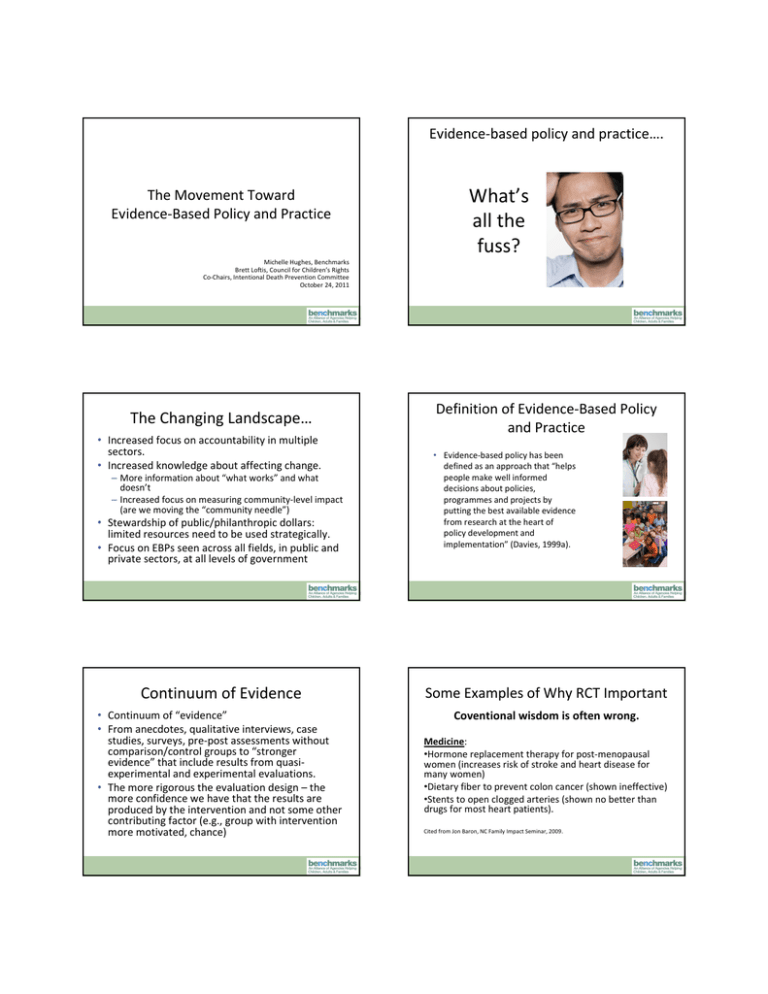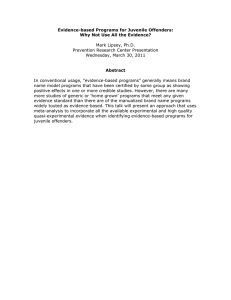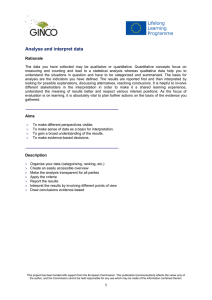CFTF 10 24 11 on EBPx
advertisement

Evidence-based policy and practice…. The Movement Toward Evidence-Based Policy and Practice What’s all the fuss? Michelle Hughes, Benchmarks Brett Loftis, Council for Children’s Rights Co-Chairs, Intentional Death Prevention Committee October 24, 2011 The Changing Landscape… • Increased focus on accountability in multiple sectors. • Increased knowledge about affecting change. – More information about “what works” and what doesn’t – Increased focus on measuring community-level impact (are we moving the “community needle”) • Stewardship of public/philanthropic dollars: limited resources need to be used strategically. • Focus on EBPs seen across all fields, in public and private sectors, at all levels of government Definition of Evidence-Based Policy and Practice • Evidence-based policy has been defined as an approach that “helps people make well informed decisions about policies, programmes and projects by putting the best available evidence from research at the heart of policy development and implementation” (Davies, 1999a). Continuum of Evidence Some Examples of Why RCT Important • Continuum of “evidence” • From anecdotes, qualitative interviews, case studies, surveys, pre-post assessments without comparison/control groups to “stronger evidence” that include results from quasiexperimental and experimental evaluations. • The more rigorous the evaluation design – the more confidence we have that the results are produced by the intervention and not some other contributing factor (e.g., group with intervention more motivated, chance) Coventional wisdom is often wrong. Medicine: •Hormone replacement therapy for post-menopausal women (increases risk of stroke and heart disease for many women) •Dietary fiber to prevent colon cancer (shown ineffective) •Stents to open clogged arteries (shown no better than drugs for most heart patients). Cited from Jon Baron, NC Family Impact Seminar, 2009. More Examples…Social Interventions BUT evidence alone is not enough….!!! Prevention : •DARE – ENORMOUS support for DARE. At one point, DARE taught in 80% of the school districts in the United States, in 54 other countries around the world, and was taught to 36,000,000 students each year (Hanson, D J., cited from www.alcoholfacts.org) – Pre-post assessments indicate increased student knowledge of risks, and improved attitude changes toward using alcohol & drug use, however, RCTs revealed program has no effect in reducing alcohol/drug use. Cited from Jon Baron, NC Family Impact Seminar, 2009. Implementation MATTERS! • Successfully replicating evidence-based programs requires…. Proven practice + fidelity/quality implementation = Better Outcomes • Fidelity: adherence to core elements which contribute to effectiveness • A poorly implemented practice/program will yield poor outcomes (and results in a poor investment) Improved outcomes for children and families Implementation, Implementation, Implementation….and…. IMPLEMENTATION!!! Insufficient Methods • Implementation by laws/compliance by itself does not work • Implementation by “following the money” by itself does not work • Implementation without changing supporting roles and functions does not work • Diffusion/dissemination of information by itself does not lead to successful implementation • Training alone, no matter how well done, does not lead to successful implementation Fixsen, Naoom, Blase, Friedman, Wallace, 2005 Why the CFTF Has Been So Effective Im (fidelity measurement) Training Selection Systems Intervention rs i ve Dr on ati ni z ga Or Co mp et en cy Dr i ve rs Coaching Facilitative Administration Integrated & Compensatory Leadership Technical © Fixsen & Blase, 2008 n tio ta e n rs em ve pl Dri Performance Assessment Adaptive Decision Support Data System • Uses data to inform our understanding of needs/problems • Asks the question -- where is our final destination (what is the outcome we want) • Uses evidence in policy making – What do we know is effective in addressing this issue? – How do we know? What is the evidence? Future Directions Resources • With social interventions, need for increased focus both on the “what” (effective interventions) AND the “how” (what does it take to implement effectively) • How can we begin to help support effective implementation of recommended interventions? • Coalition for Evidence-Based Policy http://coalition4evidence.org/wordpress/ • Duke University Center for Child and Family Policy, Family Impact Seminar on Evidence-Based Policy http://familyimpactseminars.org/index.asp?p=1&page =seminar&seminarid=181&siteid=34 • National Implementation Research Network http://www.fpg.unc.edu/~nirn/ • NIRN Financing Evidence-Based Program and Practices Brief http://www.fpg.unc.edu/~nirn/resources/publications /financing_paper_final_2008.pdf – EFFECTIVE direct service delivery needs a supportive infrastructure (clinical supervision, pre-service and inservice training, coaching, & program evaluation) – NIRN Brief on Financing of Evidence-Based Programs and Practices



